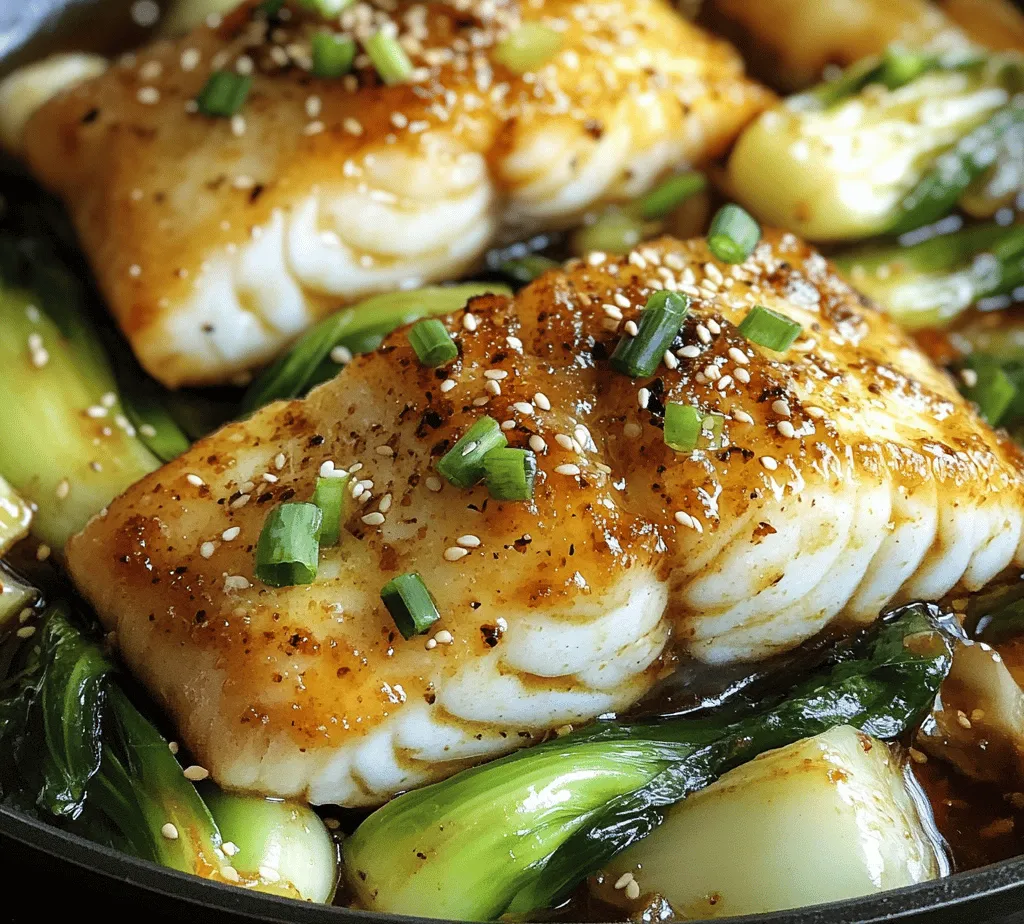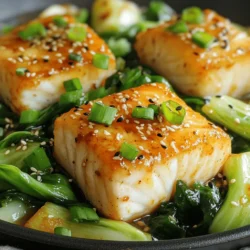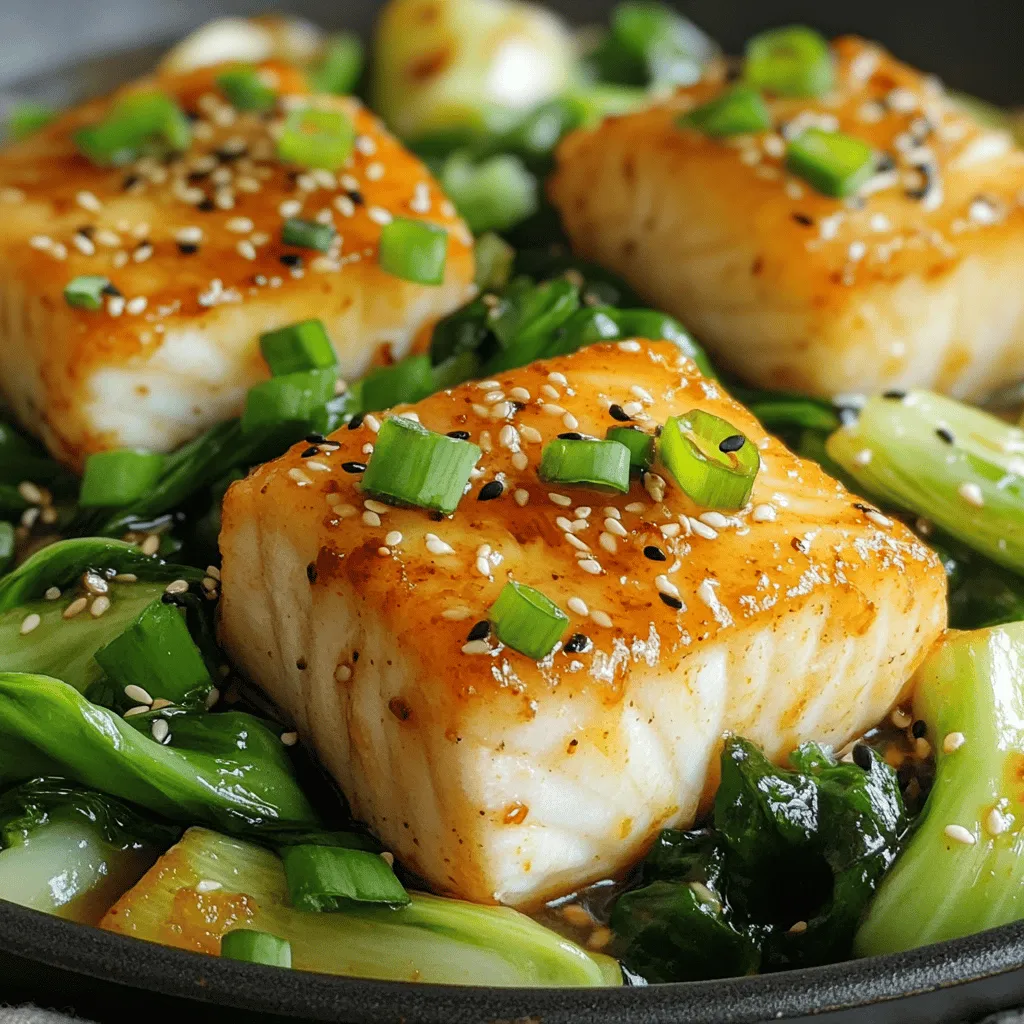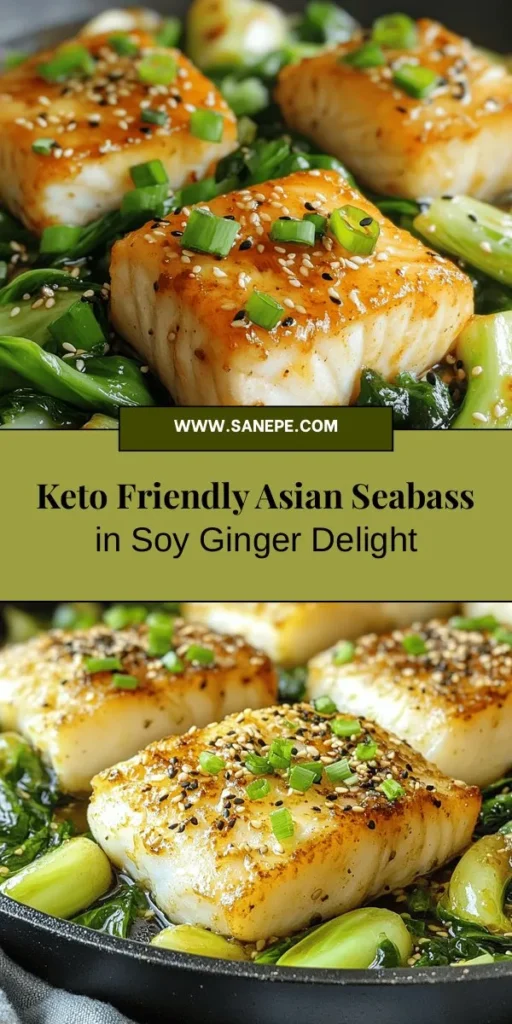Introduction
The culinary world is filled with a vast array of flavors and dishes, but few can rival the exquisite taste of Chilean seabass. This luxurious fish, known for its rich, buttery texture, pairs beautifully with a variety of ingredients, making it the perfect centerpiece for an unforgettable meal. In this article, we will explore how to prepare a delectable Keto Asian-Inspired Chilean Seabass in Soy Ginger Sauce. This dish not only satisfies your taste buds but also adheres to the principles of a ketogenic diet, making it a fantastic choice for those looking to enjoy flavorful meals while maintaining their health goals.
As modern diets evolve, the focus on low-carb and keto-friendly recipes has gained momentum. The keto diet emphasizes high-fat, moderate protein, and low-carb consumption, encouraging the body to enter a state of ketosis where it burns fat for energy. This dietary shift has led many to seek out recipes that are not only nutritious but also packed with flavor. Our Asian-inspired seabass dish is a prime example of how you can indulge in rich, savory meals without sacrificing your health.
Asian cuisine is renowned for its vibrant flavors, often achieved through the use of fresh ingredients and aromatic spices. The combination of soy sauce, ginger, and garlic creates a harmonious blend that elevates the taste of the seabass, while also providing numerous health benefits. Let’s dive into the ingredients that make up this delightful dish and explore their nutritional advantages.
Understanding the Ingredients
Overview of Chilean Seabass
Chilean seabass, also known as Patagonian toothfish, is a prized fish that hails from the southern oceans around South America. Its firm, white flesh and delicate flavor make it a favorite among chefs and home cooks alike. One of the standout features of Chilean seabass is its high-fat content, which contributes to its tender texture and rich taste. This makes it an ideal choice for keto dieters who need to incorporate healthy fats into their meals.
Nutritional Benefits
Beyond its delectable flavor, Chilean seabass is a source of essential nutrients. A 3-ounce serving contains approximately 20 grams of protein and is rich in omega-3 fatty acids, which are known for their heart-healthy properties. These healthy fats can help reduce inflammation, support brain health, and promote overall wellness. Additionally, seabass is low in carbohydrates, making it an excellent protein source for those following a ketogenic lifestyle.
Flavor Profile and Cooking Properties
The flavor profile of Chilean seabass is mild yet buttery, allowing it to absorb the flavors of the accompanying ingredients beautifully. When cooked, it becomes flaky and tender, making it an excellent canvas for a variety of sauces. Whether you choose to grill, bake, or pan-sear the fish, its cooking properties lend themselves well to various culinary techniques.
The Role of Soy Sauce and Alternatives
Soy sauce is a staple ingredient in many Asian dishes, renowned for its umami flavor and depth. However, for those following a keto diet, it’s essential to choose the right version of soy sauce or consider alternatives. Traditional soy sauce contains gluten and can be high in sodium, which may not align with everyone’s dietary preferences or restrictions.
Explanation of Soy Sauce vs. Coconut Aminos
Coconut aminos have gained popularity as a soy sauce alternative, especially among those on gluten-free or paleo diets. Derived from the sap of coconut trees and aged with sea salt, coconut aminos boast a slightly sweeter taste and a lower sodium content compared to soy sauce. This makes it a suitable option for keto dieters, as it contains no added sugars and is low in carbohydrates.
Health Implications for Keto Dieters
Choosing the right soy sauce or alternative is crucial for maintaining a healthy keto lifestyle. While soy sauce can be enjoyed in moderation, opting for coconut aminos can help lower sodium intake and avoid potential allergens. As always, it’s essential to read labels and select products that align with your dietary needs.
Fresh Ginger and Garlic: Flavor Enhancers
Ginger and garlic are fundamental ingredients in Asian cuisine, known for their aromatic qualities and health benefits. Fresh ginger adds a warm, spicy flavor that complements the seabass beautifully, while garlic contributes a robust depth of flavor. Both ingredients are not only delicious but also packed with antioxidants and anti-inflammatory properties.
Health Benefits and Culinary Uses
In addition to their flavor-enhancing abilities, ginger and garlic have been recognized for their health benefits. Ginger is known to aid digestion, reduce nausea, and may even help lower blood sugar levels. Garlic, on the other hand, is celebrated for its immune-boosting properties and potential cardiovascular benefits. Incorporating these ingredients into your dishes not only elevates the flavor but also adds a nutritional punch.
Sesame Oil and Its Significance in Asian Cooking
Sesame oil is another key player in Asian cuisine, known for its nutty flavor and fragrant aroma. It is commonly used as a finishing oil to enhance dishes and provide a rich depth of flavor. In this recipe, sesame oil will be used to sauté the vegetables and add a delightful aroma to the overall dish.
The Importance of Low-Carb Sweeteners in Keto Recipes
Many Asian recipes use sugar or other high-carb sweeteners to balance flavors. However, for those on a keto diet, finding suitable low-carb alternatives is essential. Erythritol, a sugar alcohol, is one such option that provides sweetness without the carbs. It has a minimal impact on blood sugar levels and can be used in a variety of recipes, making it a popular choice for keto dieters.
Explanation of Erythritol and Other Alternatives
Erythritol is unique among sugar substitutes because it is mostly absorbed by the body, while the remaining amount is excreted without undergoing metabolism. This means it has negligible calories and does not spike blood sugar levels, making it an ideal sweetener for those following a ketogenic diet. Other alternatives include stevia and monk fruit, both of which offer sweetness with minimal to no carbs.
Preparation Steps
Marinating the Seabass
One of the key steps in preparing Keto Asian-Inspired Chilean Seabass is marinating the fish. Marination is crucial for flavor infusion, allowing the seabass to soak up the delicious soy ginger sauce, resulting in a dish that is bursting with flavor.
To create the marinade, you’ll need a combination of soy sauce or coconut aminos, fresh ginger, garlic, sesame oil, and erythritol (or your preferred low-carb sweetener). The balance of salty, sweet, and aromatic components will enhance the natural flavors of the seabass.
Detailed Instructions for Preparing the Marinade
1. In a mixing bowl, combine 1/4 cup of soy sauce or coconut aminos, 1 tablespoon of freshly grated ginger, 2 cloves of minced garlic, 1 tablespoon of sesame oil, and 1 tablespoon of erythritol.
2. Whisk the ingredients together until well combined. Taste the marinade and adjust the sweetness or saltiness according to your preferences.
3. Place the seabass fillets in a shallow dish or resealable plastic bag and pour the marinade over them. Ensure each fillet is well coated.
4. Cover the dish or seal the bag and refrigerate for at least 30 minutes, allowing the flavors to meld and penetrate the fish. For best results, marinate for 1 to 2 hours.
Cooking the Bok Choy
While the seabass is marinating, you can prepare the accompanying bok choy. This leafy green vegetable not only adds a vibrant color to the plate but also offers numerous nutritional benefits. Bok choy is low in calories but high in vitamins A, C, and K, as well as minerals like calcium and potassium.
To cook the bok choy, you will want to sauté it in a little sesame oil. Here’s how to do it:
1. Rinse the bok choy under cold water to remove any dirt or grit. Trim the ends and cut the bok choy in half lengthwise.
2. In a large skillet or wok, heat 1 tablespoon of sesame oil over medium-high heat.
3. Add the bok choy to the skillet, cut side down, and sauté for 2-3 minutes until the leaves begin to wilt.
4. Flip the bok choy and cook for an additional 2-3 minutes until tender but still vibrant green.
5. Season with a pinch of salt and pepper, and drizzle a little extra soy sauce or coconut aminos for added flavor, if desired.
As you prepare the bok choy, the aroma of ginger and garlic will fill your kitchen, setting the stage for the main event: the Chilean seabass.
In this guide, we’ve begun our journey into creating a delightful Keto Asian-Inspired Chilean Seabass in Soy Ginger Sauce. From understanding the nutritional benefits of key ingredients to the initial preparation steps, each element is designed to ensure a flavorful and satisfying meal. In the following sections, we will dive deeper into the cooking process, providing you with detailed instructions to complete this exquisite dish. Stay tuned for the continuation of this culinary adventure!

Step-by-Step Sautéing Instructions and Tips for Perfect Texture
To achieve the perfect sauté for your Keto Asian-Inspired Chilean Seabass in Soy Ginger Sauce, it’s essential to follow a few key steps that will enhance the flavor and texture of the fish.
1. Preheat the Pan: Begin by preheating a non-stick skillet or cast-iron pan over medium-high heat. Ensure the pan is hot enough to create a nice sear on the fish, which will lock in moisture and flavor.
2. Add Oil: Once the pan is heated, add a tablespoon of high-quality oil such as avocado oil or sesame oil. These oils not only have a high smoke point but also contribute to the dish’s flavor profile.
3. Prepare the Fish: Pat the Chilean seabass fillets dry with a paper towel. This step is crucial as moisture can prevent the fish from achieving that desirable golden-brown crust. Season both sides of the fillets with salt and pepper.
4. Sauté the Seabass: Carefully place the seabass fillets in the hot oil, skin-side down if applicable. Avoid overcrowding the pan; if necessary, work in batches. Allow the fish to cook undisturbed for about 4-5 minutes. This will help develop a crispy exterior.
5. Flip and Finish Cooking: After the first side is golden brown, gently flip the fillets. Cook for an additional 3-4 minutes on the other side. The fish should be opaque and flake easily with a fork when done.
6. Add the Sauce: In the last minute of cooking, pour your prepared soy ginger sauce over the fish. This will glaze the seabass and infuse it with the sauce’s flavors. Allow the sauce to simmer slightly, thickening as it coats the fish.
Cooking the Seabass: Ideal Techniques
When cooking Chilean seabass, the goal is to achieve both a perfectly cooked interior and an appealing exterior. Searing and then glazing with sauce is an ideal technique, as it allows the fish to absorb flavors while maintaining moisture.
– Searing: This technique creates a caramelized crust that enhances the umami flavor of the seabass. Ensure that your pan is hot before adding the fish to get the best sear.
– Glazing: Adding the soy ginger sauce towards the end of cooking not only adds richness but also helps keep the fish moist. The sugars in the sauce caramelize slightly, adding depth to the flavor.
Tips for Achieving Golden Color and Perfect Flakiness
– Don’t Rush the Sear: Allow the fish to cook undisturbed. If you try to flip the fish too early, it may stick to the pan and break apart.
– Use a Fish Spatula: If you have one, a fish spatula is designed for flipping delicate fillets without breaking them. If not, a regular spatula will suffice, but take care when flipping.
– Check for Doneness: The internal temperature of perfectly cooked seabass should reach around 145°F (63°C). Use a meat thermometer for accuracy.
Serving Suggestions
Plating your Keto Asian-Inspired Chilean Seabass beautifully can enhance the dining experience. Here are some suggestions to elevate your presentation:
– Plating the Dish for Visual Appeal: Start with a clean, large plate. Place the seabass fillet in the center, spooning some of the soy ginger sauce over the top. Surround the fish with a colorful array of vegetables or a small mound of cauliflower rice for contrast.
– Suggested Pairings with Other Keto-Friendly Sides: Serve the seabass with sautéed bok choy or steamed broccoli, both of which pair well with the Asian flavors of the dish. Cauliflower rice or zucchini noodles can also serve as a low-carb base that complements the fish.
– Garnishes to Elevate the Presentation: Fresh herbs such as cilantro or scallions can add a pop of color and freshness. A sprinkle of sesame seeds adds a nice crunch and visual appeal. A wedge of lime on the side can enhance the dish’s flavors when squeezed over just before eating.
Nutritional Breakdown
Understanding the nutritional content of your meal is vital for maintaining a balanced keto lifestyle. Here is a detailed nutritional analysis per serving of the Chilean seabass:
– Calories: Approximately 350
– Total Fat: 20g
– Saturated Fat: 4g
– Protein: 38g
– Total Carbohydrates: 6g
– Fiber: 2g
– Net Carbs: 4g
Health Benefits of the Ingredients
– Chilean Seabass: Rich in omega-3 fatty acids, which are known for their anti-inflammatory properties and heart health benefits.
– Soy Sauce: Provides a savory umami flavor and contains antioxidants.
– Ginger: Known for its digestive benefits and anti-inflammatory properties, ginger adds warmth and spice to the dish.
– Garlic: Offers numerous health benefits, including boosting the immune system and having antimicrobial properties.
This dish not only fits perfectly into a ketogenic diet but also provides essential nutrients that support overall health.
Variations and Customizations
One of the great aspects of cooking is the ability to adjust recipes to suit personal tastes and dietary needs. Here are some suggestions for variations and customizations:
– Alternative Fish Options: If Chilean seabass is not available, consider using salmon, halibut, or even firm white fish like cod. Each of these varieties will lend its unique character to the dish while maintaining the overall flavor profile.
– Adjusting Spice Levels: For those who enjoy a bit of heat, consider adding red pepper flakes or sriracha to the soy ginger sauce for an extra kick. Conversely, if you prefer a milder flavor, reduce the amount of ginger or omit it altogether.
– Variations in Vegetables: Depending on the season, you can introduce different vegetables. Asparagus, bell peppers, or snap peas can be sautéed and added alongside the seabass for a colorful, nutrient-packed dish.
Cultural Context
Asian cuisine is celebrated for its bold flavors, aromatic spices, and health-conscious ingredients. The use of soy sauce, ginger, and garlic in this dish reflects traditional Asian cooking practices that emphasize balance and harmony in flavors.
This Keto Asian-Inspired Chilean Seabass embodies the fusion of health-conscious eating with traditional Asian flavors, illustrating how modern dietary preferences can harmoniously blend with time-honored culinary techniques. The dish not only adheres to the principles of a ketogenic diet but also showcases the vibrant and rich cultural heritage of Asian cuisine.
Conclusion
The Keto Asian-Inspired Chilean Seabass in Soy Ginger Sauce is a delightful dish that brings together health, flavor, and elegance. With its rich nutritional profile and easy preparation, it stands out as an excellent choice for anyone seeking to maintain a keto lifestyle without sacrificing taste.
This dish encourages exploration of Asian-inspired cooking, proving that healthy eating can be both enjoyable and flavorful. By experimenting with various ingredients, flavors, and cooking techniques, you can create a multitude of delicious meals that align with your dietary goals. Embrace the journey of healthy cooking, and let flavors inspire you to make nutritious choices that you truly enjoy.


